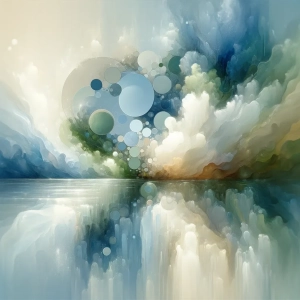The Science of Active Imagination in Mind-Body Integration
A Systematic Exploration of Visualization and Its Physiological Impacts

In the dynamic flow of human consciousness, where thoughts weave through the warp and weft of emotion and reason, lies a profound capability often left unexplored: the power of active imagination. This process, significantly illuminated by Carl Jung, transcends mere daydreaming to forge a bridge between the conscious and unconscious realms, fostering a dialogue rich with personal insight and transformation. Yet, the influence of active imagination extends beyond the confines of the psyche, reaching into the physical realm to manifest tangible effects on the body.
Part One: The Lemon Experience – An Overture to the Mind-Body Symphony
Imagine holding a ripe, vibrant lemon, its surface dotted with pores, heavy with juice. As you slice it open, the tangy scent fills the air, a bright yellow juicy interior. Now, picture squeezing this lemon into a spoon and bringing the spoon to your lips. Almost instinctively, your mouth begins to water, a clear indication of our imaginal mind’s power to affect the body.
This simple exercise not only demonstrates the vividness of active imagination but also highlights the immediate physiological responses it can evoke, providing a tangible entry point into the exploration of the mind-body connection. By understanding how visualizing a lemon can trigger salivation, we open the door to deeper insights into how our perceptions and thoughts influence our bodily states.
Part Two: Theoretical Foundations and Applications of Active Imagination
Active imagination, a term coined by Carl Jung, stands as a cornerstone in the realm of analytical psychology, offering a bridge between the conscious and unconscious mind. This process involves engaging with imagery and thoughts that arise from the unconscious, allowing for a dialogue with the deeper aspects of the self. This section delves into the underpinnings of this concept, its psychological mechanisms, and its profound impact on personal development and therapy.
The Roots in Jungian Psychology
Carl Jung posited that the unconscious mind was a source of wisdom and insight that, if accessed and integrated with our conscious awareness, could lead to profound personal growth and wholeness. Active imagination serves as a meditative practice whereby individuals turn their attention inward, engaging with spontaneous images, fantasies, and thoughts without judgment or intervention. This engagement allows for the unconscious content to come to the forefront, facilitating insight, integration, and transformation.
Psychological Mechanisms
The efficacy of active imagination lies in its capacity to bypass the ego’s defenses and rational structures, tapping directly into the symbolic language of the unconscious. Through this process, individuals can confront unresolved issues, emotional blockages, and psychological complexes, fostering a reconciliation of conflicting parts within themselves. This direct engagement with the unconscious catalyzes a transformative healing process, promoting psychological equilibrium and the individuation process, a term Jung used to describe the journey towards self-realization and wholeness.
Applications in Therapy and Personal Development
In therapeutic settings, active imagination is used as a tool to explore and resolve inner conflicts, traumas, and anxieties. Therapists guide clients through the process, helping them interpret the symbols and narratives that emerge, and integrating these insights into their conscious understanding. Beyond therapy, active imagination is a valuable practice for anyone seeking to enhance creativity, problem-solving skills, and personal insight. By fostering a dialogue with the unconscious, individuals can access a wellspring of creative ideas, discover new solutions to problems, and gain deeper insights into their desires, fears, and aspirations.
Expanding the Horizons: Beyond Individual Transformation
Active imagination also holds implications for cultural and societal development. Jung believed that the collective unconscious, a reservoir of the experiences and knowledge of humanity, could be accessed through active imagination, providing insights into collective myths, symbols, and archetypes. This understanding can foster a deeper connection to the collective human experience, promoting empathy, cultural appreciation, and a sense of interconnectedness.
By exploring the theoretical underpinnings and applications of active imagination, we can appreciate its profound impact on mind-body integration, personal development, and even societal cohesion. This process not only fosters personal growth and healing but also enhances our understanding of the human psyche’s depth and complexity.

Part Three: The Misogi Experience – A Dive into Purification and Renewal
Misogi, a traditional Japanese practice, involves purification under a waterfall. It’s not merely a physical cleansing but a profound spiritual renewal, inviting practitioners to release their burdens to the water. This ancient ritual, deeply rooted in Shinto beliefs, symbolizes the purification of the body and spirit, a washing away of impurities and the renewal of one’s inner self. Though physically demanding, the essence of Misogi is its symbolic act of rejuvenation, accessible to anyone through the power of active imagination.
Guided Misogi Visualization:
Close your eyes and imagine yourself standing before a majestic waterfall in a secluded, verdant forest. The air is crisp, filled with the misty spray from the falls. You hear the powerful rush of water cascading down, a soothing yet invigorating sound that fills you with anticipation. Take a deep breath in, and as you exhale, step forward into the cool, clear water at the edge of the pool.
Feel the chill of the water against your skin, invigorating and alive. With each step, the water rises, first caressing your ankles, then your knees, embracing you with its purity. Now, standing at the base of the waterfall, you look up to see the water tumbling down from above, a shimmering curtain of liquid crystal.
As you step into the waterfall, the cold water envelops you, but it does not shock; instead, it invigorates, washing over you in waves of energy. Imagine this water not just touching your skin, but moving through you, cleansing you of worry, doubt, and all that weighs on your mind and spirit. Each droplet carries away tension, leaving your body lighter, your thoughts clearer.
The water is powerful, yet it does not overwhelm. Instead, it’s the perfect force, strong enough to carry away burdens but gentle enough to refresh and renew. Stand there for a moment, under the waterfall, and feel the sensation of being cleansed from within.
As you step back from the waterfall, you notice the lightness of your being, a sense of renewal that permeates your body and mind. The burdens you carried into the water have been washed away, leaving you refreshed, revitalized, and ready to move forward with clarity and purpose.
Conclusion:
This guided visualization of Misogi reflects the transformative power of active imagination. Just as the water of the waterfall purifies and renews, so too can our minds cleanse and rejuvenate our being through vivid, purposeful visualization. By engaging in this practice, we harness the ability to let go of the mental and emotional burdens that hinder us, emerging lighter, freer, and imbued with a renewed sense of vitality.
Through the explorations presented in this paper, we have journeyed from the tangible sensation of tasting a lemon, driven solely by the force of our imagination, to the spiritual and emotional renewal symbolized by the Misogi ritual. These examples serve not only to illustrate the profound impact of active imagination on the mind-body connection but also to highlight its potential as a powerful tool for personal development, healing, and self-discovery.
Active imagination, as we have seen, is more than a mental exercise; it is a gateway to deeper understanding, a method for personal transformation, and a path to unlocking the untapped potentials within us. By embracing and practicing this potent cognitive process, we can explore the depths of our consciousness, engage with our innermost selves, and emerge transformed, ready to face the world with renewed clarity, purpose, and vitality.
As we conclude this exploration, we invite readers to continue engaging with their own active imagination, discovering its limitless possibilities and the myriad ways it can enrich their lives. Let the journey of imagination be not an end but a beginning, a continuous unfolding of the mind’s power to shape our reality, heal our wounds, and inspire our spirits to soar.
